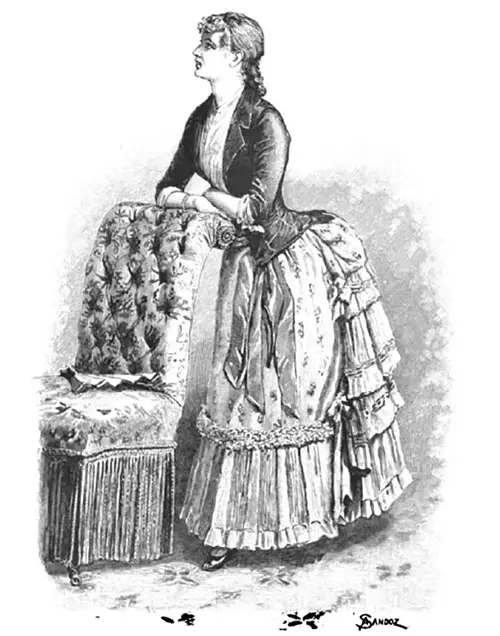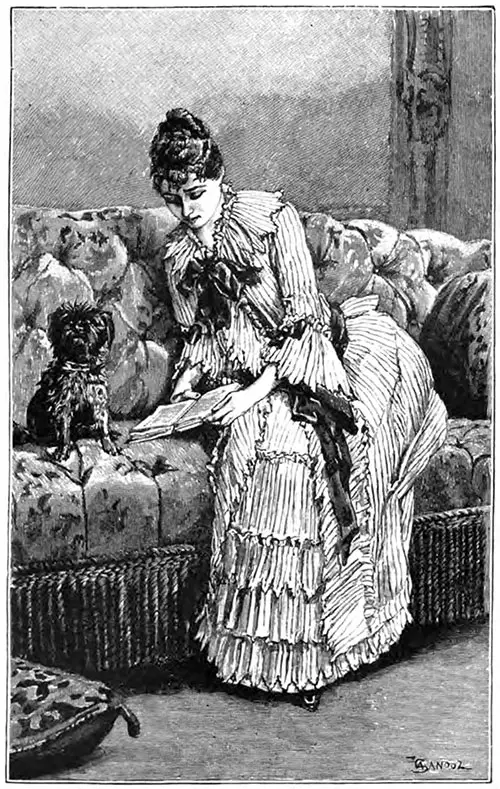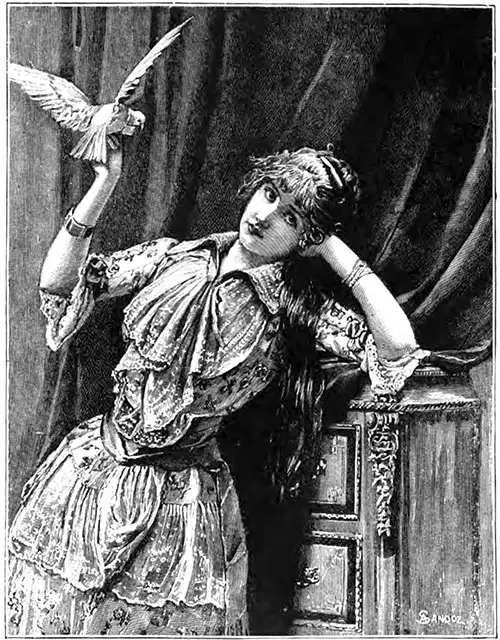Paris Fashions October 1888
Autumn and spring are the favorite seasons for marriages. The wedding trousseaux of Mlle. de Brissac, who last August married the Duc de Lorge, of Mlle de Mailte, who married the Comte de Fleury, and those of other high-born damsels entering the state of wedlock, occupied the attention of all fashionable Paris.

Costume, from the Maison Cély.
Lingerie and Undergarments
Our celebrated lingères were so busy making up fairy-like under garments, that they knew none of the dullness of the dead season. Every young betrothed dreams of her trousseau.
These delicate chiffons impart a poetry and refinement to a woman's personality. The modern siren owes not a little of her subtle seductiveness to the grace and finish of every detail of her attire.
It is by the daintiness of her underclothing that the truly elegant woman is distinguished. The care lavished upon hidden garments is the note of a delicate self-respect.
The French bourgeoises, and also it must be admitted some other foreign women, are too often perfectly satisfied with their apparel if they can flaunt gowns laden with lace or gaudy with trimmings.
As a rule, the Frenchwoman is careful of her lingerie, and in every grade of life the young fiancée is proud to display to her friends on the day of her contract the pretty bravery of lace-trimmed and embroidered under-linen.
Diamonds are coveted only after the due supply has been obtained of textures fine as wrought cobwebs, white as carded wool, finished off with lace and coquettish knots of ribbon.
Silk chemises enriched with Brussels lace; cambric chemises bordered above and below with a wide insertion of Valenciennes and edged with a gathered flounce of lace; short petticoats of cambric and Surah silk; morning wraps and pocket handkerchiefs, stockings, and caps, all made exquisite with needlework, sweet with perfume, gay with fastenings of ribbon, are the choicest properties of the bride elect.
By sets of half-dozen, the fashionable trousseau contains a variety of chemises. There is the full-dress chemise of cambric richly trimmed with Valenciennes; for ordinary wear it is of fine linen edged with narrow Valenciennes; for country wear it is of colored cambric of Pompadour design, striped or spotted, trimmed with fancy lace.
Silk chemises are increasing in favor every day: blue, pink, white, cream, lilac, and lemon, ripe corn and poppy-red, black even they are of every shade and color. These silken under garments are edged and richly trimmed with white or black lace.
They are made in various shapes and patterns. There is the Marie Antoinette chemise, cut low in a point; the Tallien chemise, high in the neck, and the throat outlined by an insertion of ribbon, the shoulders trimmed with several rows of lace.
The newest fabric used for under-clothing is silk crêpe. It has risen so greatly into popularity that its vogue threatens to supplant that of silk and silken gauze.
The fashion for garments in this material is to make them very short, very full, very much gathered, and every article of each set of the same exact shade of color.
The chemise, cut round the shoulders, does not reach down to the knees; the wide knickerbockers are fastened above the knees; the tiny petticoat, etc., is scarcely longer.
Ribbons fasten at the throat, at the waist, and form the garters of this singular lingerie. It is made in delicate pink, blue, white, maize, red, and in black especially. The stays are of satin of the same shade.
Mme. Cely have made silk crepe the fashion for under-garments; these lingères hold with the Maison Morin-Blossier, which has lately added a lingerie to its dressmaking establishment, Rue de la Paix, the first rank for the manufacture of feminine under-clothing.
Like the day-chemise, the night-gown is composed of cambric or thin foulard silk, trimmed with lace and ribbon. For country and seaside wear, night-gowns are of colored cambric or spotted foulard, the edge festooned and worked in silk thread of the same color.
The last fashion for night-gowns is to make them flowing like a judge's gown; the yoke is gathered; the deep collar is turned back with a festooned border; the sleeve is trimmed with double-gathered wrist-bands; at the waist, collar, and sleeves are placed flowing knots of ribbon.
The under-petticoats for evening wear are of cambric covered with Valenciennes; for morning wear they match the stays, which in their turn harmonize with the general tone of the dress. Be the stays of Pompadour watered silk, of shot faille, or of tortoise-shell brocade, the petticoat is of the same stuff and color.
These underskirts are flat, edged with one or many lace flounces placed upon quilling of the material. When the petticoat is of shot silk several small flounces pinked out and gathered take the place of lace.
Stockings and Hosiery
The stockings are varied and fanciful. Silk stockings adorned with insertions of lace or made delicately transparent with open-work are suited to evening wear.
For morning dress, the fancy silk stockings are embroidered with Pompadour designs, spotted, striped, covered with tiny squares; the thread stockings are in every variety of design, intricately woven and delicately dyed.
It is de rigueur that the stockings match the color of the gowns with which they are worn. Such details make a woman's dress complete and carry out the artistic idea of her apparel as a whole. There must not be a jarring note of color, not a neglected item.
Bridal Trousseaux and Hand-Made Lace
Handkerchiefs are an important feature of a bridal trousseau — airy trifles exquisitely wrought with the needle, or richly trimmed with lace. For evening wear, the handkerchief must be formed of alternate lace and cambric, or deeply edged with lace.
For the day, it may be simply hemmed with transparent stitches, or finely embroidered, the initials worked in the corner. Foulard handkerchiefs are as fashionable as cambric for the day; these, too, must be daintily edged with needlework and initialed.
A word here may not be out of place in praise of ornamental needlework. Machine-stitching at one time threatened to supplant that wrought by the essentially feminine implement—the needle. We are glad to see on every side signs of a revival of this handiwork.
These bridal trousseaux were all hand-made and hand-ornamented. Embroidery, at its best, is a fine art; it is the fine art of women. The question of whether to deck our clothes with embroidery and lace may appear trifling, and yet the answer may be taken as a fairly sure index of a nation's social and political state.
In times of security and prosperity, the finest art-work, including that of the needle, has been achieved. In times of disorder, embroidery and lace-making have declined.
During the French Revolution, the lace-making and embroidery industries were very nearly ruined by edicts forbidding the use of these fabrics.
The vulgarity of machine-wrought embroidery springs from the sundering of the work from the skill of deft and patient fingers, working under the guidance of a ruling taste.
The ornamentation of the under-linen of these bridal trousseaux was exquisite for finish of execution and grace of design. The plain sewing had a distinction scarcely second to the more elaborate needlework.
The pearly evenness of the stitches, their variety and delicacy, seemed invested with some of that moral significance which, philosophers assure us, underlies all our conceptions of beauty.
As we are on the chapter of hand-made lace and bridal trousseaux, we may mention here, as an example of exquisite workmanship, the lace dress sent by the Empress Eugenie to her young kinswoman, the Princess Letitia Bonaparte, married last September, as a wedding gift.
The beautiful Empress of the French had worn the lace on her wedding-day, and for many years had treasured it in the hope of seeing it worn by her son's bride on her marriage-day. The Prince was destined never to have a bride.
The costly lace was, nevertheless, to be worn by a Bonaparte. The design—garlands and festoons of violets, the favorite flowers of Napoleon—is a marvel of richness and grace; the execution is of unrivalled beauty.
Perhaps the most coquettish of the pretty garments destined for the bride's morning dress are the tiny caps of her trousseau. These miniature head-gears, usually not much larger than a hand, are of every fantastic and graceful shape: Russian caps, Bulgarian, Marie Antoinette, Marie Louise, the Infanta, the Dauphine, the Normande cap. the Charlotte Corday: they are composed of lace, of ribbons, of embroidery, of gold braid, of flowers; all sorts of pretty odds and ends enter into the manufacture of the "bonnichons."
Morning Gowns
For morning gowns, soft, clinging stuffs are preferable, such as Surah, Corah, and Chinese silks. These graceful negligees are profusely adorned with lace and ribbon.
I saw a pretty morning vest in China silk, the pleated chemisette gathered and crossed in Tosca fashion, the jacket edged with a deep border of lace and trimmed with knots of flowing ribbon, the sleeves gathered and finished off with knots of ribbon at the wrists.

Costume from the Maison Morin-Blossier
A simple morning gown may be composed of a bed jacket and petticoat to match. The same supple fabrics are used. I saw one of Pompadour Chinese silk, the cream ground covered with a graceful design of flowers; the back and front of the jacket were gathered; a thick jabot of Breton lace fastened by knots of ribbon gave a delicate touch of finish to the unconventional attire; the open sleeves were trimmed with the same lace.
The morning wrap, a long, straight peignoir, worn on getting out of bed, is also made of soft material, usually of pongee silk of various shades. It is edged with a scalloped flounce, the open sleeve is scalloped, also the deep-pointed collar and jabot.
A Watteau pleat falls in a graceful sweep at the back; ribbon knotted in front forms the sash. Four or five morning dresses at least, of varied degrees of elegance, form part of these bridal trousseaux.
These morning "at home" costumes can be made of the richest stuffs, and their fashion leaves a certain latitude for originality in design and color.
A dress which flattered the eye by the richness of its hues and the grace of its lines was of Pompadour brocade, the pink satin ground striped with many-colored blossoms.
The gown was a long, closely-fitting, sleeveless redingote, opening in front, and cut open at the sides, disclosing a straight, finely, pleated under-garment of black crepe, with wide sleeves, which were gathered at the wrists with bands of white velvet embroidered in gold. The collar and sash of this quaintly elegant gown were also of white velvet embroidered in gold.
Another déshabillé, less dressy but not less elegant, was of Pompadour poplinette, the ground the color of ripe corn. The skirt in front was covered with three flounces of lace.
At the back, continuing the line of the Directoire jacket which formed the bodice, a breadth of the stuff fell in straight, flat folds.
A lace scarf issuing from the flat, pink satin collar was crossed over the bust like a fichu, then turned to edge the jacket. Deep lace cuffs and knots of pink satin ribbon adorned the Maintenon sleeves; a wide pink satin sash-scarf was knotted behind.
Another picturesque Empire déshabillé was also of Pompadour poplinette of a pink ground. The under-garment worn with this ample redingote was of finely- pleated cream cambric.
The deep collar, the revers, and sash-scarf were of very pale willow-green watered silk, the shade harmonizing delightfully with the rose-colored ground.
The graceful déshabillé, the design of which forms one of our illustrations, was of cream-colored Indian foulard, striped all over with tiny rose-colored lines. The skirt was covered with flounces, festooned, and worked with exquisite embroidery in rose colored silk thread.
The casaque Lamballe, fitting the figure at the back, fell straight and flowing in front, and was edged all round with a similarly worked flounce, which also formed the border of the sleeves, and re-appeared in the wide Pierrot collar fastened at the throat with a kind of pink watered ribbon. The flowing sash of pink watered ribbon passed under the Lamballe jacket and was knotted at the side.
The use of ribbon—worn at the collar, at the sleeves, around the waist—is on the increase. It adorns linen; it is seen on the simplest dress as on the costliest, watered ribbon, embroidered ribbon, ribbon in beautiful soft chiné silk, where the woven flowers look as seen through a tender veil of mist, are all fashionable.
Large blossoms of natural size and hues—lilac, iris, pansies, poppies, carnations, roses, and ox-eyed daisies—thrown in clusters upon a light ground, appear on sashes wide as scarfs.
The sash usually springs from the right side and is twisted round to the left side, where it is knotted, and falls in flowing ends that sway with every movement of the wearer's figure.

Morning Costume from the Maison Morin-Blossier
One item of dress not to be overlooked is the garter. Every day its fashion grows more luxurious. The garter matches the stocking and the under-clothing with which it is worn.
It is usually made of pleated watered silk, fastened by a jewel, placed in a knot of black or white lace, according to the lace trimming the under garments.
In these days, when dress has never been more soigne or luxurious in all its details, there is a certain heroism in Mme. de Valsayre's persistent attempt to win her countrywomen over to Bloomerism. This lady lately petitioned the Chamber to pass a law authorizing women to wear trousers and modified coats.
The Committee of the House appointed to look into the lady's petition found no sumptuary law forbidding womankind to don masculine costume. Mme. de Valsayre was triumphant.
Henceforth she dreamt superfluous draperies, impeding skirts, would be laid aside, and women would step forth in garments suited to the free development of their muscles.
The lady appealed to Worth, as the king and legislator of dressmakers, to devise some beautiful costume, composed of trousers and vest, for the feminine sex. This sovereign legislator in matters of taste refused, however, to comply with her request.
He knew the feminine love of graceful chiffons too well. Mme. de Valsayre does not push her own theories of dress reform to their bitter end. If she wears trousers it is only in the modified form of what you in England call the "divided skirt."
For myself. I cannot imagine our dress-loving Parisiennes stalking about in trousers or laying aside their pretty draperies for the austere ungainliness of the divided skirt.
I have left myself no space to treat of the autumn fashions. One thing is certain, the "bustle" is doomed. Everything is tending increasingly to the obliteration of bunched-up draperies.
The lines of skirts are simpler and longer. Blouses are growing shorter, and the Empire bodice will be the bodice of the coming winter season.
There is perceptible a disregard for la taille, once so much the note of Parisian elegance. Cloaks are worn loose and full, hanging in pleats from the shoulders; their quaint old-fashioned air is heightened by triple collars, graduated in size, crossing the shoulders.
As for the bonnets and hats, they have fallen from their high estate. All the glory of piled-up blossoms, towering knots of ribbon, waving aigrettes, is extinguished. The hats are low-crowned; the bonnets close-fitting, fastened with wreaths of foliage, clustered blossoms, and berries.
Green remains a favorite color; and with the deepening autumn, chaplets of vine leaves, brambles, hazel-boughs, and hop-leaves take more and more the place of flowers, and twine in a coronal around many fair heads.
Johnstone, Violette, “October Fashions: Paris,” in The Woman’s World, Cassell & Company, Limited, London, Paris, New York & Melbourne, Volume I, No. 12, October 1888, p. 569-572.
Editor's Note: Some terminology used in the description of women's clothing during the 1800s and early 1900s has been changed to reflect more modern terms. For example, a women's "Toilette" -- a form of costume or outfit has an entirely different common meaning in the 21st century. Typical terms applied to "toilette" include outfit, ensemble, or costume, depending on context.
Note: We have edited this text to correct grammatical errors and improve word choice to clarify the article for today’s readers. Changes made are typically minor, and we often left passive text “as is.” Those who need to quote the article directly should verify any changes by reviewing the original material.

